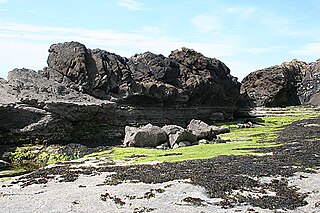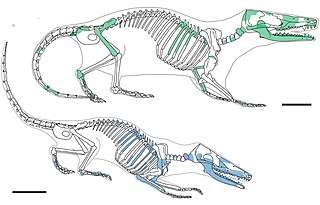Related Research Articles

The Middle Jurassic is the second epoch of the Jurassic Period. It lasted from about 174.1 to 161.5 million years ago. Fossils of land-dwelling animals, such as dinosaurs, from the Middle Jurassic are relatively rare, but geological formations containing land animal fossils include the Forest Marble Formation in England, the Kilmaluag Formation in Scotland, the Calcaire de Caen of France, the Daohugou Beds in China, the Itat Formation in Russia, the Tiouraren Formation of Niger, and the Isalo III Formation of western Madagascar.

Lepidosauromorpha is a group of reptiles comprising all diapsids closer to lizards than to archosaurs. The only living sub-group is the Lepidosauria, which contains two subdivisions, Squamata, which contains lizards and snakes, and Rhynchocephalia, the only extant species of which is the tuatara.

Duriavenator is a genus of theropod dinosaur that lived in what is now England during the Middle Jurassic, about 168 million years ago. In 1882, upper and lower jaw bones of a dinosaur were collected near Sherborne in Dorset, and Richard Owen considered the fossils to belong to the species Megalosaurus bucklandii, the first named non-bird dinosaur. By 1964, the specimen was recognised as belonging to a different species, and in 1974 it was described as a new species of Megalosaurus, M. hesperis; the specific name means 'the West' or 'western'. Later researchers questioned whether the species belonged to Megalosaurus, in which many fragmentary theropods from around the world had historically been placed. After examining the taxonomic issues surrounding Megalosaurus, Roger B. J. Benson moved M. hesperis to its own genus in 2008, Duriavenator; this name means "Dorset hunter".
Eileanchelys is an extinct genus of primitive turtle from the Middle Jurassic (Bathonian) period some 164 million years ago of Britain. Only one species is recorded, Eileanchelys waldmani. It is the best-represented turtle from the Middle Jurassic, because of the amount of specimens that can be assigned to it. The turtle is also one of the oldest turtles ever found to be aquatic, and might represent a milestone in turtle evolution.

Paleontology or palaeontology is the study of prehistoric life forms on Earth through the examination of plant and animal fossils. This includes the study of body fossils, tracks (ichnites), burrows, cast-off parts, fossilised feces (coprolites), palynomorphs and chemical residues. Because humans have encountered fossils for millennia, paleontology has a long history both before and after becoming formalized as a science. This article records significant discoveries and events related to paleontology that occurred or were published in the year 2009.
Susan Elizabeth Evans is a British palaeontologist and herpetologist. She is the author or co-author of over 100 peer-reviewed papers and book chapters.

Reptiles arose about 320 million years ago during the Carboniferous period. Reptiles, in the traditional sense of the term, are defined as animals that have scales or scutes, lay land-based hard-shelled eggs, and possess ectothermic metabolisms. So defined, the group is paraphyletic, excluding endothermic animals like birds that are descended from early traditionally-defined reptiles. A definition in accordance with phylogenetic nomenclature, which rejects paraphyletic groups, includes birds while excluding mammals and their synapsid ancestors. So defined, Reptilia is identical to Sauropsida.

The Karauridae are a family of stem-group salamanders (Caudata) that are known from the Middle Jurassic to Early Cretaceous in Central Asia, Northern Asia and Western Europe. The family includes four members: Karaurus from the Middle-Late Jurassic Karabastau Formation of Kazakhstan, Kokartus from the Middle Jurassic Balabansai Formation of Kyrgyzstan, Marmorerpeton from the Middle Jurassic Forest Marble Formation of England and Kilmaluag Formation of Scotland, and Kuzbassia from the Early Cretaceous (Aptian) Ilek Formation. The members are some of the oldest known salamanders. The family is united by several morphological characters, including sculptured skull roof bones. Like some modern salamanders, karaurids were neotenic. Members of the family likely fed via suction feeding on small fish and invertebrates. The Early Cretaceous Siberian Kulgeriherpeton has been suggested to be a karaurid by some authors.

Marmoretta is an extinct genus of small lepidosauromorph reptile known from the Middle Jurassic (Bathonian) of Britain, as well as the Late Jurassic of Portugal. It contains a single species, Marmoretta oxoniensis.

Stereognathus is an extinct genus of tritylodontid cynodonts from the Middle Jurassic of the United Kingdom. There is a single named species: S. ooliticus, named after the Great Oolite deposits of England. A second species, S. hebridicus, was named after the Hebrides in Scotland, where it was found; it was synonymized with S. ooliticus in 2017.

The Kilmaluag Formation is a Middle Jurassic geologic formation in Scotland. It was formerly known as the Ostracod Limestone for preserving an abundance of fossil freshwater/low salinity ostracods. Gastropods, bivalves, trace fossil burrows, and vertebrate fossil remains have also been recorded from the formation. Vertebrate fossils include fish, crocodylomorphs, mammals, small reptiles, amphibians, theropod and sauropod dinosaurs and pterosaurs.

Amphitherium is an extinct genus of stem cladotherian mammal that lived during the Middle Jurassic of England. It was one of the first Mesozoic mammals ever described. A recent phylogenetic study found it to be the sister taxon of Palaeoxonodon. It is found in the Forest Marble Formation and the Taynton Limestone Formation.

Robert Joseph Gay Savage was a British palaeontologist known as Britain's leading expert on fossil mammals. He worked at the University of Bristol for nearly 40 years and studied fossils around the world, especially in North and East Africa. He produced the 1986 popular science book Mammal Evolution: An Illustrated Guide and co-edited several technical books in the Fossil Vertebrates of Africa series with fellow palaeontologist Louis Leakey.
Montirictus is an extinct genus of tritylodonts known from the Early Cretaceous Kuwajima Formation of Japan. It was among the latest surviving tritylodontids, and is closely related to the earlier Xenocretosuchus from mainland Asia, and the Jurassic Stereognathus from the UK. It may be a species of the genus Stereognathus, but resolution of its affinities conditions upon the discovery of additional material.

Borealestes is a genus of docodontan from the Middle Jurassic of Britain, first discovered on the Isle of Skye near the village of Elgol. It was the earliest mammaliaform from the Mesozoic found and named in Scotland. A second species and was later found in other Middle Jurassic sites in England, but is now shown to be a different genus. A new species, B. cuillinensis was named in 2021, also from Skye.
Wareolestes rex is a mammaliaform from the Middle Jurassic (Bathonian) rocks of England and Scotland. It was originally known from isolated teeth from England, before a more complete jaw with teeth was found in the Kilmaluag Formation of Skye, Scotland.

Palaeoxonodon is an extinct genus of cladotherian mammal from the Middle Jurassic of England and Scotland.
Krusatodon is a genus of extinct docodont mammaliaform from the Middle Jurassic of the United Kingdom. It is known from remains found in the Forest Marble Formation and also from the Kilmaluag Formation on the Isle of Skye, Scotland.
Dobunnodon its an extinct genus of docodont from the Middle Jurassic (Bathonian) Forest Marble Formation of England, first discovered in Oxfordshire near the village of Kirtlington. The type species, D. mussettae, was originally named as a species of Borealestes in 2003.
Ceoptera is an extinct genus of darwinopteran pterosaur from the Middle Jurassic Kilmaluag Formation of Scotland. The genus contains a single species, C. evansae, known from a partial skeleton. It is the only pterosaur from Kilmaluag Formation. Ceoptera represents the second pterosaur named from Scotland, after Dearc in 2022.
References
- 1 2 3 Panciroli, Elsa; Benson, Roger B. J.; Walsh, Stig; Butler, Richard J.; Castro, Tiago Andrade; Jones, Marc E. H.; Evans, Susan E. (2020). "Diverse vertebrate assemblage of the Kilmaluag Formation (Bathonian, Middle Jurassic) of Skye, Scotland". Earth and Environmental Science Transactions of the Royal Society of Edinburgh. 111 (3): 135–156. doi: 10.1017/S1755691020000055 . ISSN 1755-6910.
- ↑ "Ancient salamander was hidden inside mystery rock for 50 years – new research".
- ↑ "Rare Jurassic mammal fossil from Scotland is new species". 27 January 2021.
- ↑ "Take to the Skye: New pterosaur discovery". 22 February 2022.
- ↑ Anquetin, J.; Barrett, P.M.; Jones, M.E.H.; Moore-Fay, S.; Evans, S.E. (2009). "A new stem turtle from the Middle Jurassic of Scotland: new insights into the evolution and palaeoecology of basal turtles". Proceedings of the Royal Society B: Biological Sciences . 276 (1658): 879–886. doi:10.1098/rspb.2008.1429. ISSN 0962-8452. PMC 2664364 . PMID 19019789.
- ↑ "The Isle of Skye turtle fossils discovery". 21 November 2008.
- ↑ Waldman, M. Fish from the freshwater Lower Cretaceous of Victoria, Australia: with comments on the palaeo-environment. No. 9. Palaeontological Association, 1971.
- ↑ Waldman, Michael (1974). "Megalosaurids from the Bajocian (Middle Jurassic) of Dorset". Palaeontology . 17 (2): 325–339.
- 1 2 Waldman, M.; Savage, R. J. G. (1972). "The first Jurassic mammal from Scotland". Journal of the Geological Society. 128 (2): 119–125. Bibcode:1972JGSoc.128..119W. doi:10.1144/gsjgs.128.2.0119. S2CID 128622858.
- ↑ Panciroli, Elsa; Walsh, Stig; Fraser, Nicholas C.; Brusatte, Stephen L.; Corfe, Ian (2017-09-03). "A reassessment of the postcanine dentition and systematics of the tritylodontid Stereognathus (Cynodontia, Tritylodontidae, Mammaliamorpha), from the Middle Jurassic of the United Kingdom". Journal of Vertebrate Paleontology. 37 (5): e1351448. Bibcode:2017JVPal..37E1448P. doi: 10.1080/02724634.2017.1351448 . hdl: 10138/230155 . ISSN 0272-4634.
- ↑ Waldman, M.; Evans, S. E. (1994). "Lepidosauromorph reptiles from the Middle Jurassic of Skye". Zoological Journal of the Linnean Society. 112 (1–2): 135–150. doi:10.1111/j.1096-3642.1994.tb00315.x.